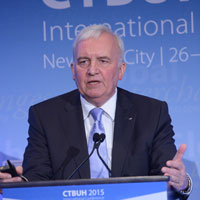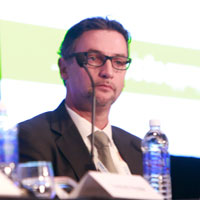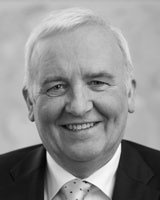Session 5c: Envelope: The Environmental Filter
Chair: Diana Darling, The Architect's Newspaper
Speakers
Click a presenter to see a video of their presentation, and the accompanying paper and PowerPoint presentation.

Jörn Teipel
Lead Technical Manager ArchitectureOutokumpu
“Stainless Steel Façades: Reflectance, Corrosion and Aesthetics”

Winfried Heusler
Senior Vice President Global Building ExcellenceSchüco
“Thinking Out of the Box – Advanced Façade Design and Technology”

Jean-Paul Moonen
Global Architecture Powder Coatings Marketing ManagerAkzo Nobel
“Skyscraper Cities: Built to Last”
Session Summary
The new skyscrapers that are turning heads around the world are not simply repeat applications of dated models. The challenge to their designers is to accommodate the rapidly evolving demands of the modern workplace to preserve and enhance the environment within and without. As a result, innovations in building envelopes have been a major driver in pushing the boundaries of skyscraper design. Presentations in this section focused on the envelope as an environmental filter, highlighting stainless steel façades, upgrades to glass and metal curtain wall designs, and new innovations in façade technology. As the sustainability of skyscraper designs are increasingly emphasized, the role that envelopes play in creating a boundary between interior and exterior space remains an important consideration.
Jörn Teipel, Product Manager, Outokumpu, began the session with a discussion on stainless steel façades and their benefits. Aside from aesthetics, stainless steel also provides a high resistance to corrosion, low maintenance, good formability, as well as being highly recyclable. These features have contributed to the material being widely used on new construction projects throughout the world, but Teipel stressed that the composition of the material should be adjusted for specific projects when designing the exterior façade. Coastal locations for example, such as those on the Arabian Peninsula near the Red Sea and Persian Gulf, require more corrosion resistance. Teipel also mentioned the recently implemented regulations regarding reflective glare now found in the cities of Singapore and Sydney, Australia. While Teipel stressed that the shape of the façade is far more responsible for the concentration of reflected light, he discussed the broader push within industry to achieve “sheen” while reducing the impact of glare.
Winfried Heusler, Senior Vice President, Schuco International KG, then discussed the need for architects and engineers to engage in cohesive design to push innovation in energy conservation as the world grows to include an additional 2.5 billion people over the next few decades. Heusler mentioned that ideal façade designs are “as technical as necessary, as simple as possible” and that the desired aesthetic of any particular project envelope is driven by three different perspectives: exterior observer, interior tenants, and building owners. He mentioned that building owners in particular have a significant concern in the building’s appearance because the building itself is the public face of that particular owner. Heusler emphasized that technology is advancing and changing faster than architects and engineers can adapt, and as such, façades should be designed for not only longevity but for future compatibility.
Finally, Ben Mitchell, Marketing Manager, AkzoNobel, discussed architectural façade coatings and the need to exploit particular material properties for buildings in different environments. Mitchell expressed the need for façades to be adapted for different climates. He mentioned that marketing is becoming increasingly important in color choice and discussed the most common reasons for the failure of pigments and resin in a detailed breakdown of a painted exterior. He then concluded by mentioning while no LEED points are currently awarded for applied coatings, there is still a push to improve the sustainability of such exteriors.






